As an Amazon Associate I earn from qualifying purchases. Please read the disclaimer for more info.
Welcome to the colorful world of orange-colored fruits. From citrus delights and tropical treasures to exotic rarities and lesser-known berries, these vibrant orange fruits offer a taste sensation for every palate.
Not only do they boast unique flavors and textures, but they also provide an array of health benefits. Are you ready to embark on a journey through the orange-colored fruit spectrum and discover some new favorites?
Key Takeaways for Orange Fruits
- Discover 18 orange-colored fruits, vegetables, and berries with a range of flavors to suit any palate.
- Citrus delights such as oranges, tangerines, and blood oranges offer tantalizing combinations of vivid color and sweet flavor.
- Exotic fruits like lucuma, kiwano (African cucumber) & gac fruit provide unique taste profiles, while pumpkin, butternut squash & bell pepper are nutritious veggies disguised as fruit!
Citrus Delights: Oranges, Tangerines, and More
Nothing quite beats the tangy-sweet taste of citrus fruits. Their bright orange hues and the juicy orange flesh are a feast for both the eyes and taste buds. Among other citrus fruits, these stand out for their vibrant color and delightful sweet flavor.
The citrus family offers a wide array of flavors and textures, with oranges, tangerines, and blood oranges being just a few examples of orange-colored fruits.
Oranges

Oranges are perhaps the most recognizable and popular orange fruit. Their sweet taste and high vitamin C content make for a delicious and nutritious snack. Oranges can be used in various recipes, such as:
- salads
- desserts
- sauces
- marinades
They can also be juiced, zested, or eaten raw, making them a versatile addition to your diet.
In many cultures, oranges symbolize good health and prosperity and find use in religious ceremonies. Beyond that, people frequently select them for juicing or creating orange liqueur.
Tangerines

The tangerine, a smaller and sweeter citrus fruit, belongs to the Mandarin family. Its distinctive features include a smaller size, a notably sweet taste, and a strong, enticing aroma. The zest of a tangerine can enhance the flavor of baked goods, while its juice can add a zesty twist to salad dressings.
Tangerines, being low in calories and high in vitamin C, are a guilt-free choice that provides health benefits. Just be careful not to overindulge, as excessive consumption can lead to gastrointestinal distress.
Blood Oranges
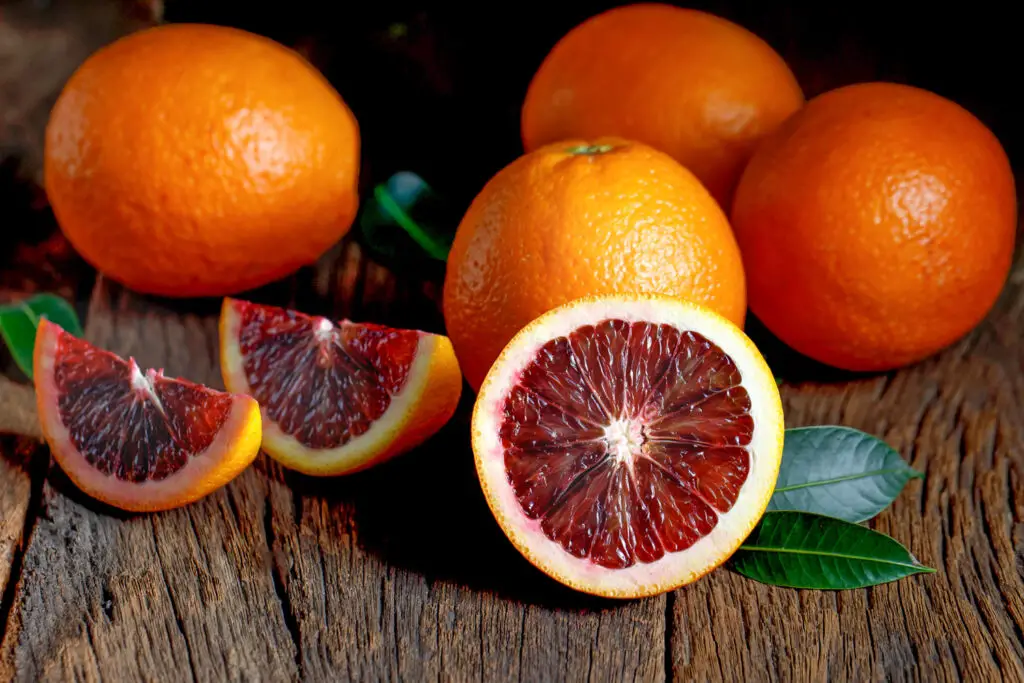
Blood oranges are a distinct variety of orange fruit with a deep red or purple interior, setting them apart from their citrus counterparts. With a flavor profile characterized by a combination of:
- sweet orange
- raspberries
- tart cherries
- grapefruit
Blood oranges, also known as the blood orange variety, offer a unique and delicious taste experience, often compared to the distinct flavor of bitter orange.
Anthocyanins, pigments found in blood oranges, are associated with potential reductions in blood pressure and lower risk of cardiovascular diseases. Their unique color and flavor make them a fantastic addition to your fruit repertoire.
Tropical Orange Fruits: Mangoes, Papayas, and Calamansi
Exploring beyond the citrus family reveals a delightful world of tropical orange fruits. Mangoes, papayas, and calamansi each offer a taste of the tropics with their vibrant flavors and enticing aromas.
From the sweet, juicy flesh of the mango to the creamy, subtly sweet taste of the papaya and the tart, zesty flavor of the calamansi, there’s a tropical orange fruit to suit every palate.
Mangoes

Mangoes, native to South Asia, are tropical fruits with sweet, juicy flesh and a thin skin. Their nectar-like flavor is often likened to a combination of peaches, pineapples, and various citrus fruits.
Mangoes make an ideal summer snack when they reach their peak between May and September. They can be incorporated into desserts, cut into smaller segments and added to salads, or blended into smoothies and juices. With their numerous health benefits, mangoes are a delicious and nutritious addition to your diet.
Papayas
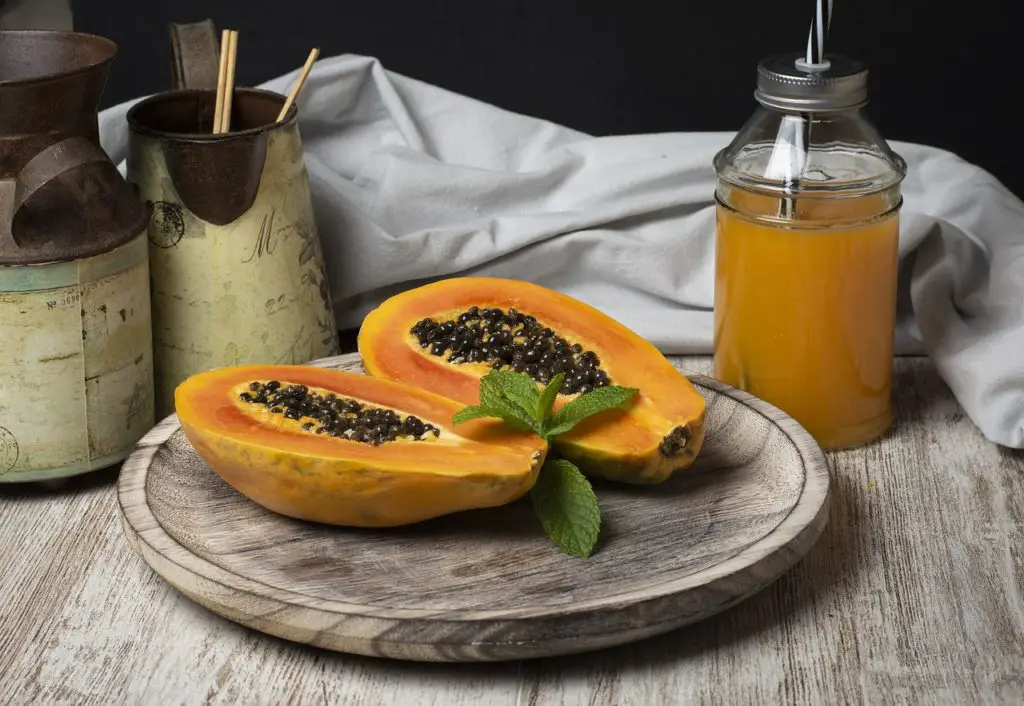
Papayas, like mangoes, are a tropical fruit with sweet, juicy flesh and thin skin. They are known for their digestive benefits, thanks to the presence of an enzyme called papain, which helps break down proteins.
Papayas can be enjoyed in various ways, such as:
- Smoothies
- Salads
- Salsas
- Desserts
A ripe papaya will be slightly soft to the touch and emit a sweet aroma. Store it in the refrigerator for up to a week.
Enjoy the taste of the tropics with this versatile and nutritious fruit.
Calamansi
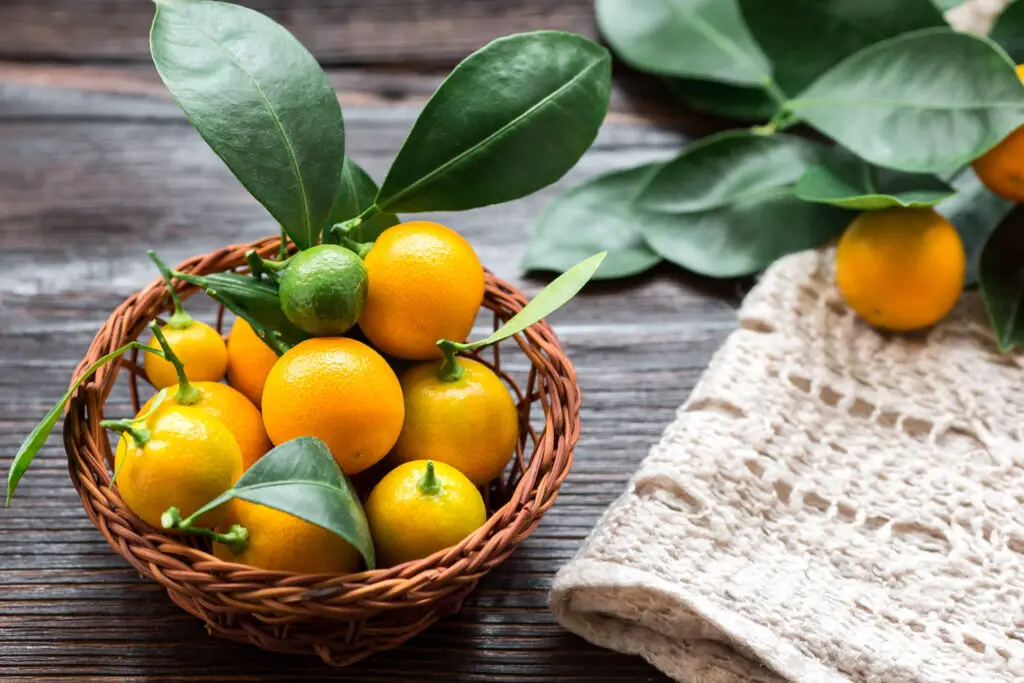
Calamansi, a small, round citrus fruit, is known for its tart taste and is commonly used in Southeast Asian cuisine. This little fruit packs a zesty punch, making it a fantastic addition to dishes such as soups, curries, and stir-fries.
It also creates sauces and marinades, adding a tangy flavor to various meals.
Consider introducing calamansi into your culinary repertoire to enjoy its tangy allure.
Stone Fruits with an Orange Twist: Apricots, Peaches, and Nectarines
If you’re looking for a different kind of orange fruit, stone fruits with an orange twist might be just what you’re after. Apricots, peaches, and nectarines each offer unique tastes and textures with sweet, tangy flavors and velvety, juicy flesh.
Explore the delightful flavors and unique characteristics of these fruits.
Apricots
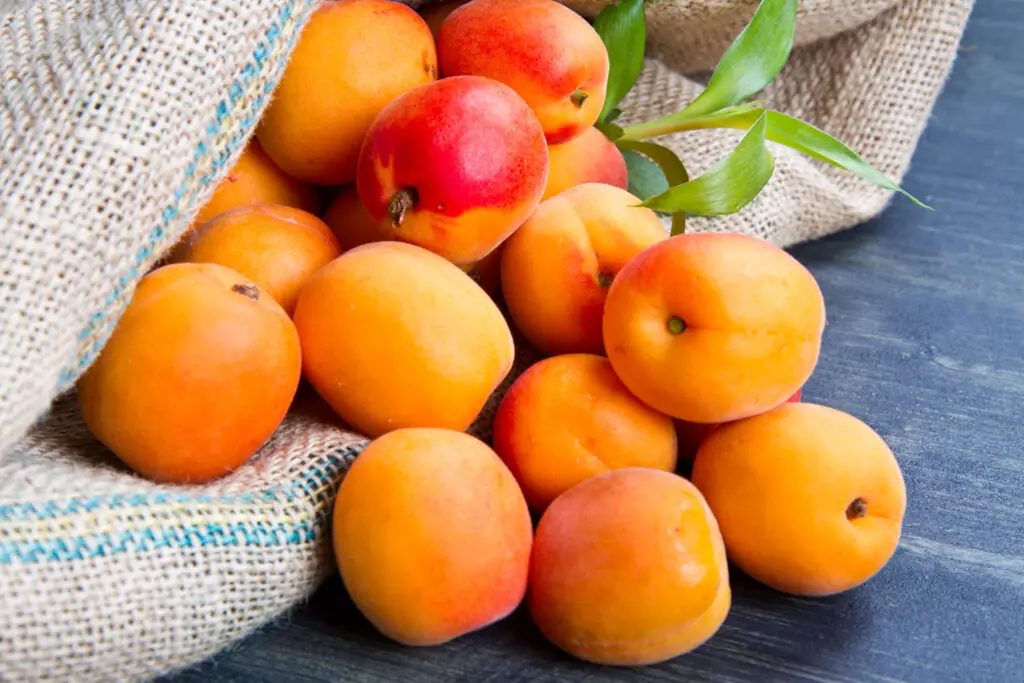
Apricots are small, sweet fruits with velvety skin and a blend of sweet and tart flavors. They are native to China and are rich in vitamins and minerals, providing various health benefits such as enhanced digestion and skin health.
Apricots can be enjoyed in various ways:
- Raw, with the skin intact
- In juices
- In salads
- In ice cream
- In cakes and desserts
- As a main ingredient in jams or chutneys
Expand your fruit horizons with this versatile and flavorful stone fruit.
Peaches
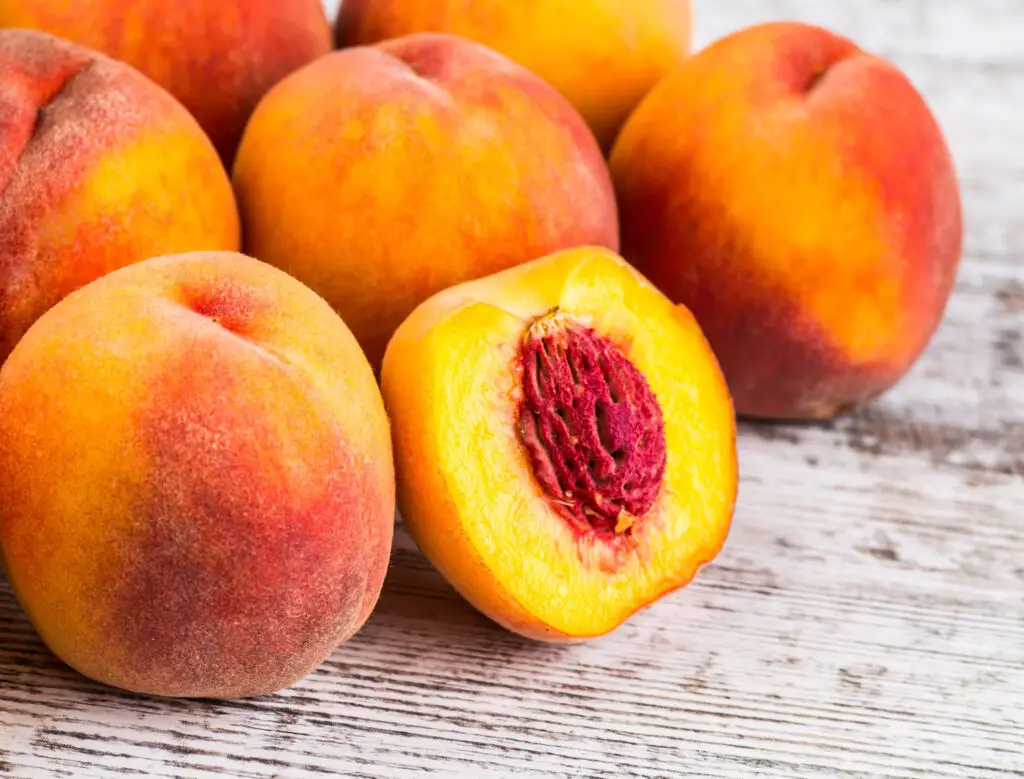
With their sweet and floral flavor, peaches are a juicy and refreshing fruit perfect for summer snacking. They are also native to China and boast high levels of fiber, antioxidants, and vitamins, offering numerous health benefits.
You can enjoy peaches in a variety of ways, including canned goods, desserts, and smoothies. Their sweet and fragrant taste makes them a delightful addition to your fruit platter.
Nectarines
Nectarines, similar to peaches but with smooth skin and slightly firmer texture, are another delightful stone fruit to add to your diet. They share the same sweet and floral flavor as peaches, with a velvety exterior and a marginally more solid consistency.
You can eat nectarines raw, include them in salads, or blend them into smoothies. They are an excellent source of vitamins and minerals and are low in calories and fat, making them a guilt-free treat.
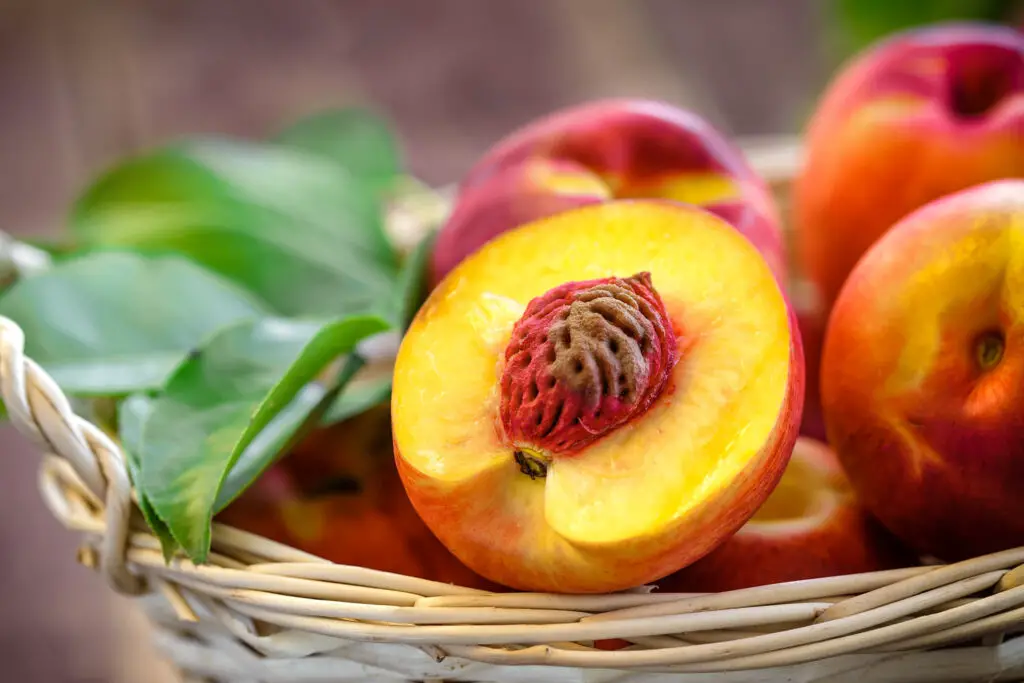
Exotic Orange Fruits: Lucuma, Kiwano, and Gac Fruit
For those with adventurous taste buds, the world of exotic orange fruits offers an exciting range of unique flavors to explore. Lucuma, kiwano, and gac fruit each bring something different to the table, from the sweet earthiness of lucuma and mild, refreshing taste of kiwano to the sweet-mild flavor of gac fruit.
Dive into the distinctive flavors of these exotic mandarin orange fruits, including the unique taste of Seville orange, the allure of sweet orange flesh, and the delightful experience of sweet oranges.
Lucuma

Lucuma is an exotic orange fruit native to South America, with a sweetness complemented by a creamy and malty flavor. Its unique taste has been compared to that of sweet potato, making it an interesting ingredient to incorporate into your dishes.
Lucuma is most commonly available in the United States in powdered and dried form. Give this sweet, earthy fruit a try to broaden your palate.
Kiwano – African Cucumber
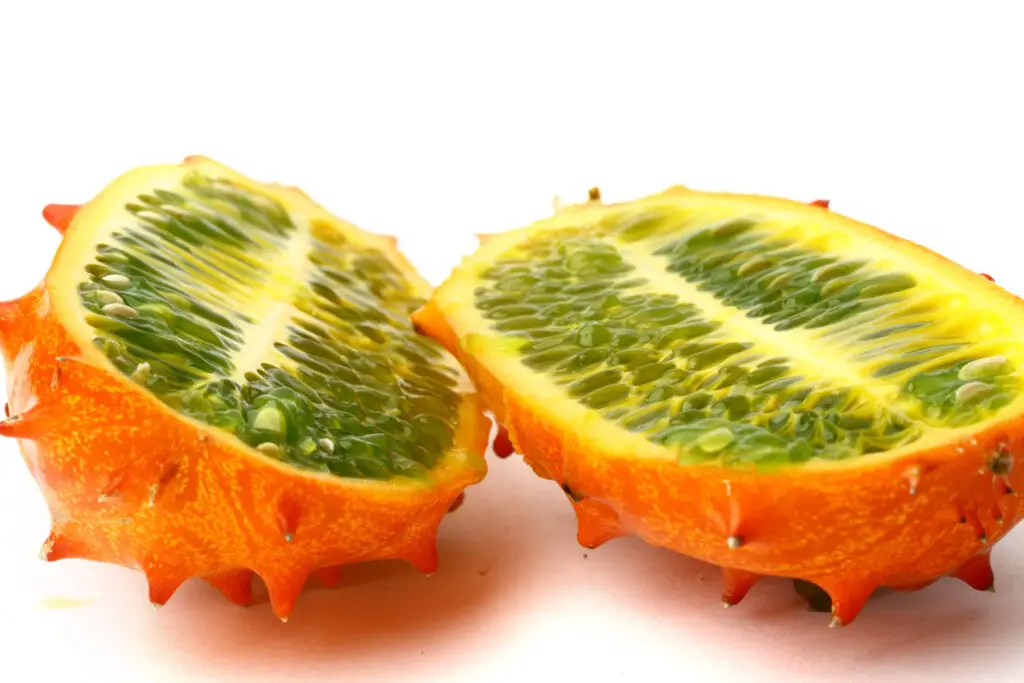
Kiwano, also known as the African cucumber, is a cucumber-like fruit with a spiked rind and a mild, refreshing taste. Its sweet and sour flavor, with a subtle hint of cucumber, makes it an intriguing addition to salads and fruit platters.
While its spiky exterior may look intimidating, the vibrant orange, jelly-like interior is a delightful treat to enjoy. Why not taste this exotic fruit and discover its unique flavor?
Gac Fruit
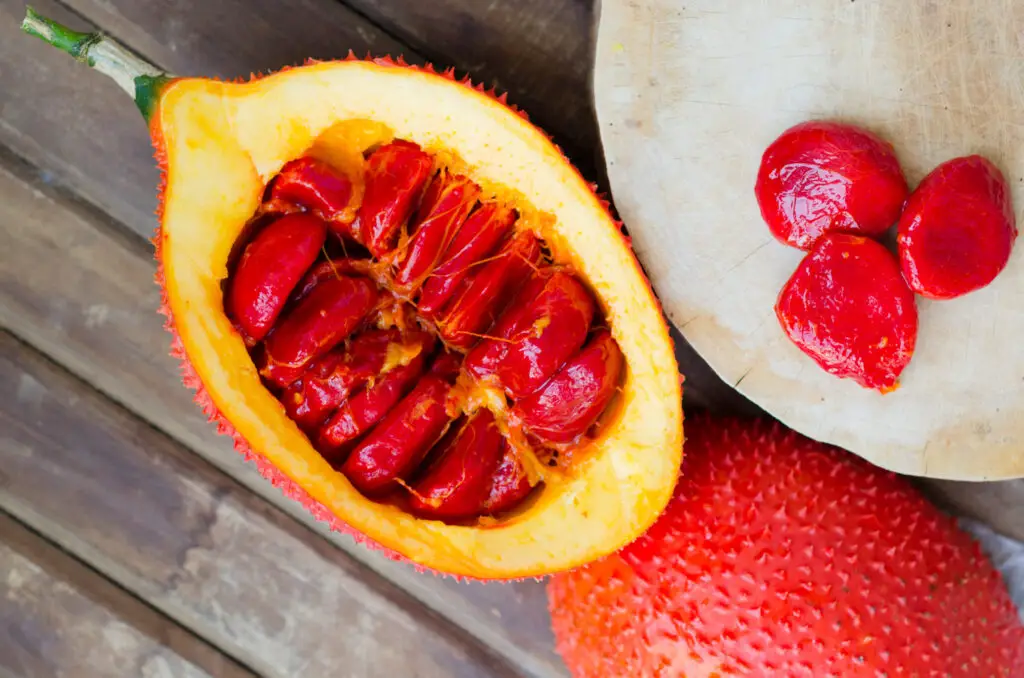
Gac fruit, an oblong-shaped fruit native to Southeast Asia and northeastern Australia, offers a sweet-mild flavor and is used in both cooking and traditional medicine. Its high nutritional value, including vitamins A, C, and E, as well as carotenoids and other antioxidants, makes it a beneficial addition to your diet.
Be it for its culinary uses or its traditional medicinal properties, gac fruit is an exotic orange fruit that deserves a try.
Lesser-Known Orange Berries: Salmonberry, Poha, and Golden Berry
If you’re looking for something a little different, the world of lesser-known orange berries offers a range of interesting flavors and textures to explore. Salmonberry, poha, and golden berry each have their own unique taste profiles, from the sweet and tart salmonberry to the sweet-tart poha and tropical sweetness of the golden berry.
Explore these intriguing orange cherry tomatoes more closely.
Salmonberry Fruit
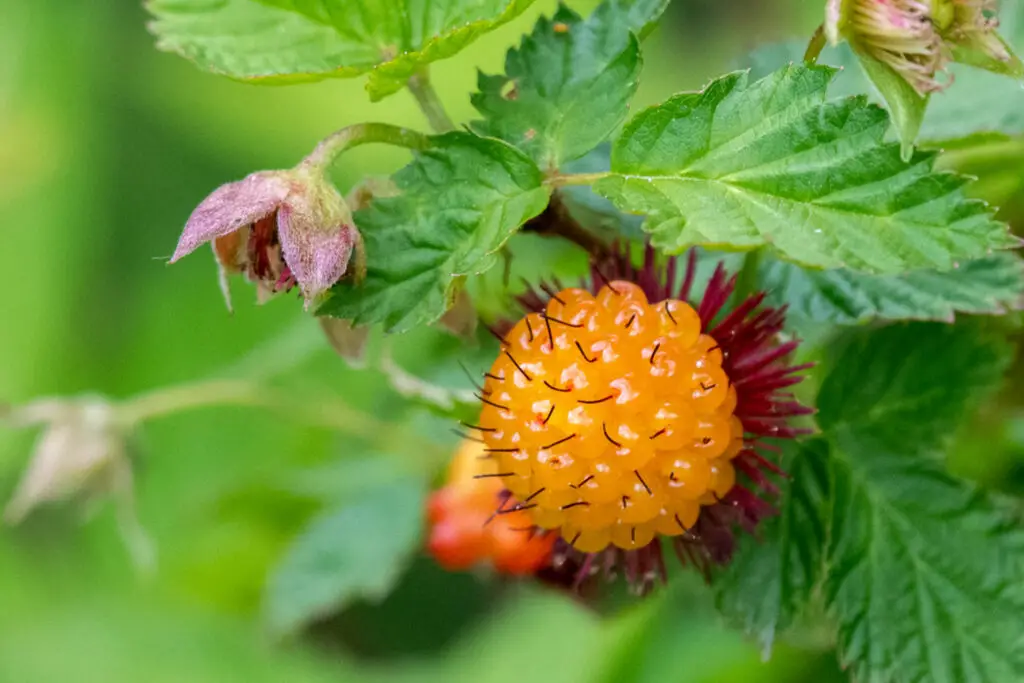
Salmonberry fruit is a bright yellow-orange berry native to North America, boasting a sweet and tart taste that is reminiscent of a raspberry and blackberry. Its vibrant color and unique flavor make it an interesting addition to fruit salads and desserts.
Consider introducing this lesser-known orange berry into your diet for a delightful taste discovery.
Poha

Poha, a small orange fruit native to the tropical regions of Colombia, Peru, and Ecuador, offers a sweet-tart flavor and grape-like texture. Its unique taste and texture make it an interesting addition to fruit salads, smoothies, and desserts.
Rich in iron and carbohydrates, Poha is also known for its various health benefits, such as regulating blood sugar levels, aiding digestion, and assisting in weight control. Taste this lesser-known orange berry and savor its unique flavor.
Golden Berry
Goldenberry, a sweet tropical fruit enveloped in a paper husk, is native to South America and boasts a delightful sweet taste. Rich in vitamins and minerals, golden berries are perfect for:
- Snacking
- Adding to salads for a burst of tropical flavor
- Using in smoothies
- Incorporating into desserts
- Serving as a pleasing accompaniment to fish and meat dishes
Broaden your fruit exploration with this lesser-known orange cherry tomato.
Orange Vegetables Disguised as Orange Fruits: Pumpkin, Butternut Squash, and Orange Bell Pepper
Not all orange-colored produce comes in the form of fruits. Pumpkin, butternut squash, and orange bell pepper are often mistaken for fruits due to their vibrant orange hues and sweet, tangy flavors.
These vegetables, each with unique flavors and health benefits, make nutritious and delicious additions to your diet.

Pumpkin
Pumpkin, a large and versatile fruit, has a mildly sweet, rich taste that can be used in a variety of dishes. Whether in pies, soups, or roasted as a side dish, pumpkin is a staple in many diets, especially during fall.
Rich in fiber and vitamins A and C, pumpkins offer numerous health benefits, such as supporting eye health, boosting the immune system, and promoting heart health. Don’t reserve pumpkins for carving alone this fall – incorporate their delicious taste and health benefits into your favorite recipes.
Butternut Squash
Butternut squash, a nutritious fruit with a rich, nutty taste, is perfect for both savory and sweet dishes. Its sweet and earthy flavor pairs well with a variety of ingredients, making it a versatile addition to your kitchen.
Rich in fiber, vitamins A and C, and antioxidants, butternut squash offers numerous health benefits, such as aiding digestion, promoting heart health, and protecting against certain diseases. Broaden your culinary exploration by including this delicious orange vegetable in your diet.
Orange Bell Pepper
Orange bell pepper, a sweet and tangy fruit from the Capsicum annuum plant, is often mistaken for a vegetable due to its vibrant orange color. Rich in antioxidants and vitamins A and C, orange bell peppers are a healthy addition to your diet, offering numerous health benefits, such as:
- Protecting against heart disease
- Boosting the immune system
- Supporting eye health
- Promoting healthy skin
- Aiding in weight loss
Their crisp, tangy taste perfectly complements salads, stir-fries, and other dishes, adding vibrant color and flavor to your meals.
Summary
Throughout this journey into the world of orange fruits, we’ve explored the flavors, textures, and health benefits of a wide range of fruits, from citrus delights and tropical treasures to exotic rarities and lesser-known berries.
Whether you’re a fan of the sweet, tangy taste of oranges and tangerines, the juicy richness of mangoes and papayas, or the unique flavors of lucuma, kiwano, and gac fruit, there’s an orange fruit out there to tantalize your taste buds and enrich your diet.
So why not step outside your fruit comfort zone and discover the wonderful world of orange fruits?
If you found this post on fruits that are orange useful, you might enjoy one of these fruit related posts:
- What Does Rambutan Taste Like and How to Eat it
- Jackfruit vs Durian: Similarities and Differences
- Korean Melon: A Guide to Taste, Origin, and More!
- The Delicious Golden Hami Melon
- Explore the Delicious Fruits in Cambodia
- 23 Tropical Fruits in Singapore – The Variety is Incredible
Frequently Asked Questions
Kumquats are miniature citrus fruits that look like oranges, native to eastern Asia. They are placed in the genus Fortunella in the Rutaceae plant family and typically have a round or oblong shape. The entire fruit is edible and gets its name from the Chinese word for ‘golden orange’.
The weird orange fruit is known as the Osage orange or Maclura pomifera. It has also been called hedge apple or bow dark, as well as mock orange, hedge, horse apple, crab apple, pap, monkey ball, monkey brains, and yellow-wood.

